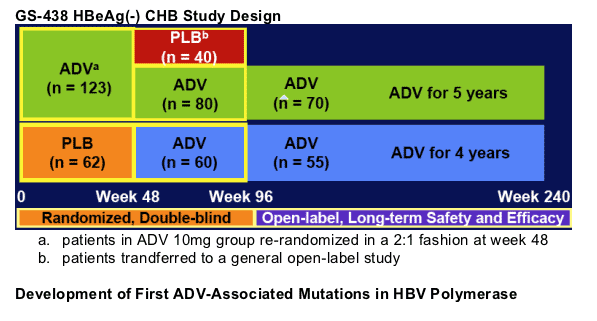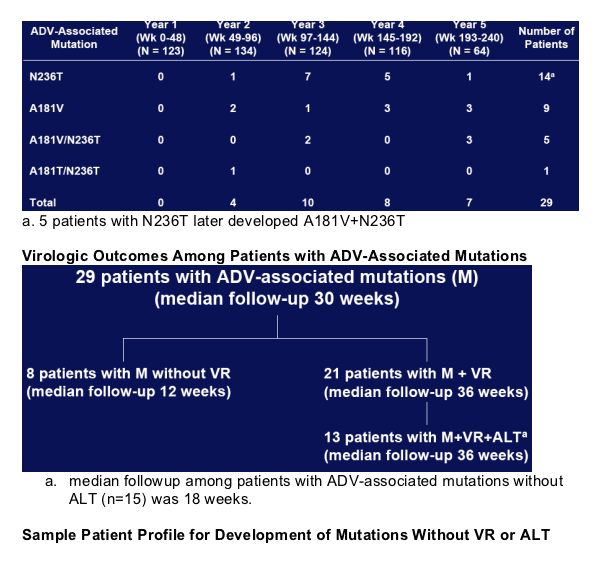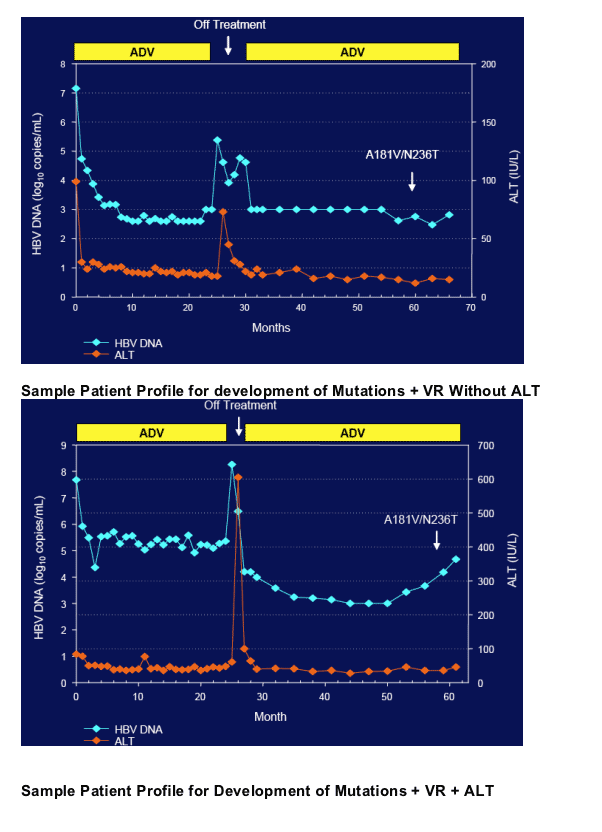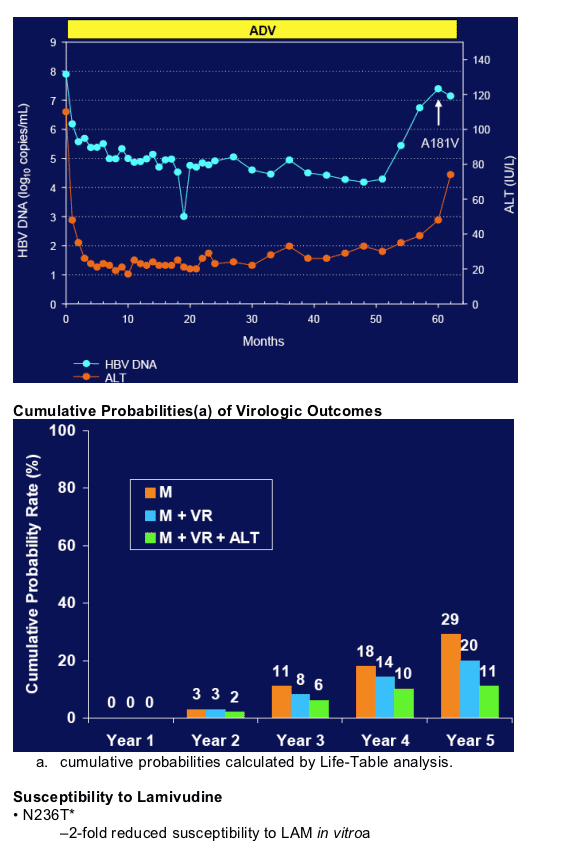 |
 |
 |
| |
Final Analysis of Virological Outcomes and Resistance During 5 Years of adefovir Dipivoxil Monotherapy in HBeAg-Negative Patients
|
| |
| |
Reported by Jules Levin
DDW May 21-24, 2006, Los Anageles
Authors: K Borroto-Esoda, S Arterburn A Snow, S Chuck, (Gilead Sciences), S Hadziyannis, (Henry Dunant Hospital, Athens, Greece), S Locarnini (Victorian Infectious Disease Reference Laboratory, Melbourne, Australia), F Zoulin (Institut Universitaire de France, Lyon, France), JM Pawlotsky (Hopital Henri Mondor, Paris, France)
Introduction
HBV resistance mutations have been identified for all oral antiviral agents used in the treatment of chronic hepatitis B (lamivudine, adefovir dipivoxil, entecavir, and telbivudine) (note from Jules Levin: no resistance has been found for entecavir in treatment-naives after the initial 2 years in studies. Entecavir resistance has been identified in a low percent of lamivudine-refractory patients treated subsequently with entecavir).
Different definitions of resistance have been used for different oral antivirals, making it difficult to compare incidence rates.
Long term treatment (4-5 years) with adefovir dipivoxil (ADV) 10 mg QD resulted in significant improvements in hepatic fibrosis, normalization of ALT and suppression of HBV DNA in the majority of patients (GS-98-438)a
(a.Hadziyannis, et al. AASLD 2005)
Study Objective
To investigate the incidence of adefovir resistance over 5 years of therapy in HBeAg-negative patients
To monitor virologic outcomes based on three categories:
- Genotypic Resistance (M) = selection of genotypic changes at critical positions rtA181V and/or rtN236T of the HBV polymerase (POL) regardless of HBV DNA level and ALT outcomes
- Virologic Resistance (M+VR) = the presence of critical genotypic changes along with HBV DNA rebound (VR); confirmed >1 log10cp/mL increase in HBV DNA from nadir and/or having never achieved HBV DNA suppression < 3 log10cp/mL
- Clinical Resistance (M + VR + ALT) = presence of critical genotypic changes along with virologic resistance and ALT elevations (ALT > 1 X ULN after normalizing ALT)
Methods
Patients and Treatment
-HBeAg-negative patients in study GS-98-438 receiving up to 5 years of ADV 10 mg QD monotherapy
Assessments
-HBV DNAaand ALT levels were collected every 4 weeks up to Week 96 of the study, and every 12 weeks thereafter
-Annual genotypic analysis was performed for all patients with HBV DNA >LLOQa
- Entire HBV RT domain sequenced
- Conserved site mutations identified at positions rtN236T and rtA181V were considered to confer resistance to adefovir dipivoxil; no novel ADV-associated mutations identified
- Cumulative probability of resistance calculated by Life Table analysis
aRoche Amplicor Monitor performed through Week 192 (LLOQ = 400 copies/mL through Week 48, 1000 copies/mL through Week 192) and Roche Cobas Taqman LLOQ = 169 copies/mL from Week 192 through Week 240.




-2 to 6 log reduction in serum HBV DNA after a median of 16 weeks (range 4-72 weeks) of add-on/switch to LAM
- A181V*
-14-fold reduced susceptibility to LAM in vitroa
-2 to 3 log reduction in serum HBV DNA after a median of 24 weeks (range 24-48 weeks) of add-on/switch to LAM
*first mutation developed
a.Locarnini, et al. EASL 2005
Conclusions
Development of ADV-associated mutations is delayed and infrequent during long-term therapy among HBeAg negative patients with chronic HBV.
Cumulative probabilities of rtN236T and/or rtA181V mutations were 0%, 3%, 11%, 18% and 29% at 1, 2, 3, 4 and 5 years, respectively.
Emergence of genotypic resistance is not always associated with HBV DNA rebound and increased ALT levels; cumulative probabilities of Virologic resistance were 20% and Clinical resistance were 11% over 5 years.
Switching or adding of LAM to patients who develop ADV-associated mutations resulted in declines of 2-6 log10 copies/mL in serum HBV DNA levels.
|
| |
|
 |
 |
|
|